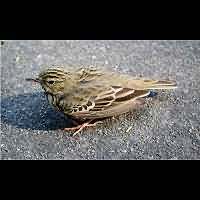Tree Pipit
All pictures on this page are thumbnails. Click on a thumbnail for an enlargement of usually some 800x600 pixels. The enlarged photos vary from 50 to 150KB in size.
Near our door: a resting Tree Pipit.
We have never seen a pipit before. In April 2003 however one landed on our doorstep. It allowed my wife to take some wonderful pictures. It probably visited our garden before, but probably we have never noticed it. From a distance it's just a rather pale, dull creature, looking like many of its Pipit relatives. To tell them apart even experts listen to these birds, rather than looking at them. This species will not visit your feeding table in winter, as it is a typical insect eater, which you can tell by the fine, long beak, which abandons Europe from October to March or April. The pipits are all rather small delicate brownish insect eaters. The wagtails are all colourful or striking black and white birds. Yet both groups belong to the same family of Passerine birds.
![]()
Tree Pipits have the typical insect eaters beak.
This bird belongs to the family of Wagtails (Motacillidae). In our garden it has been a one time visitor, but in Holland it is a common summertime bird. It is common all over the British Isles, except for Ireland en Northern Scotland. The bird is 5.8" and weighs 23 grams. It lives mostly on the edges of woodlands. Strict insect eater. The sexes do not differ from one another. It is almost impossible to tell the Tree Pipit apart from its cousin the Meadow Pipit. Tree Pipits make their nest on the ground from April to July. Only five to six eggs are produced, which hatch after 13 days. Some 11 days later the chicks leaf the nest.
![]()
| Name of this bird in various other languages | ||||
| Dutch | German | French | Polish | Scientific |
| Boompieper | Baumpieper | Pipit des arbres | Swiergotek drzewny | Anthus trivialis |





